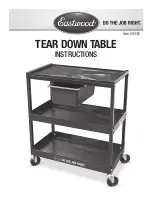
EonStor U16U Installation and Hardware Reference Manual
2-4
Hardware Installation Preparation
♦
Note on using RAID
- No RAID system is 100 percent fault-proof, routine backup
of your data is still necessary.
2.3.3 Static-Free
Installation
Static electricity can damage the electronic components of the system. Most of the
controllers that are returned for repair are the results of improper installation and ESD
damage. To prevent ESD damage to any of the components, before touching or handling
them follow these precautions:
♦
When installing the ES A16F, a user should wear an anti-static wrist band or touch a
grounded metal surface to discharge any static electricty form his/her body.
♦
Avoid carpets, plastic, vinyl or styrofoam in the work area.
♦
Handle any components by holding its edges or metal frame. Avoid touching PCB
boards or connector pins.
2.4. Hardware Installation Preparation
2.4.1 Tools or Equipment Needed for Installing the Subsystem
The only tools necessary are #2 cross-head Phillips and 3/16” slotted screwdrivers.
2.4.2 Planning Before Installation
♦
Module Locations
- Make sure you are aware of the related positions of each plug-in
module and interfaces.
♦
I/O path configurations
- The ES subsystems provide a total of four (4) or six (6) IO
channels interfaced through two (2) or four (4) SCSI ports (depending on the model
type). There are always two SCSI ports for connecting to host computers. Drives
channels are routed through the back-end PCBs to drives mounted within the
enclosure.
♦
Expansion Ports
- The 6-channel model provides another two SCSI ports on its
controller box. These ports should be used to expand system capacity by cascading
to a JBOD.
♦
SCSI Port Variations
-
The 4 channel model
: two SCSI ports for host connection
The 6 channel model
: two SCSI ports for host connection, and two SCSI
ports on the controller box for cascading to a JBOD.
















































